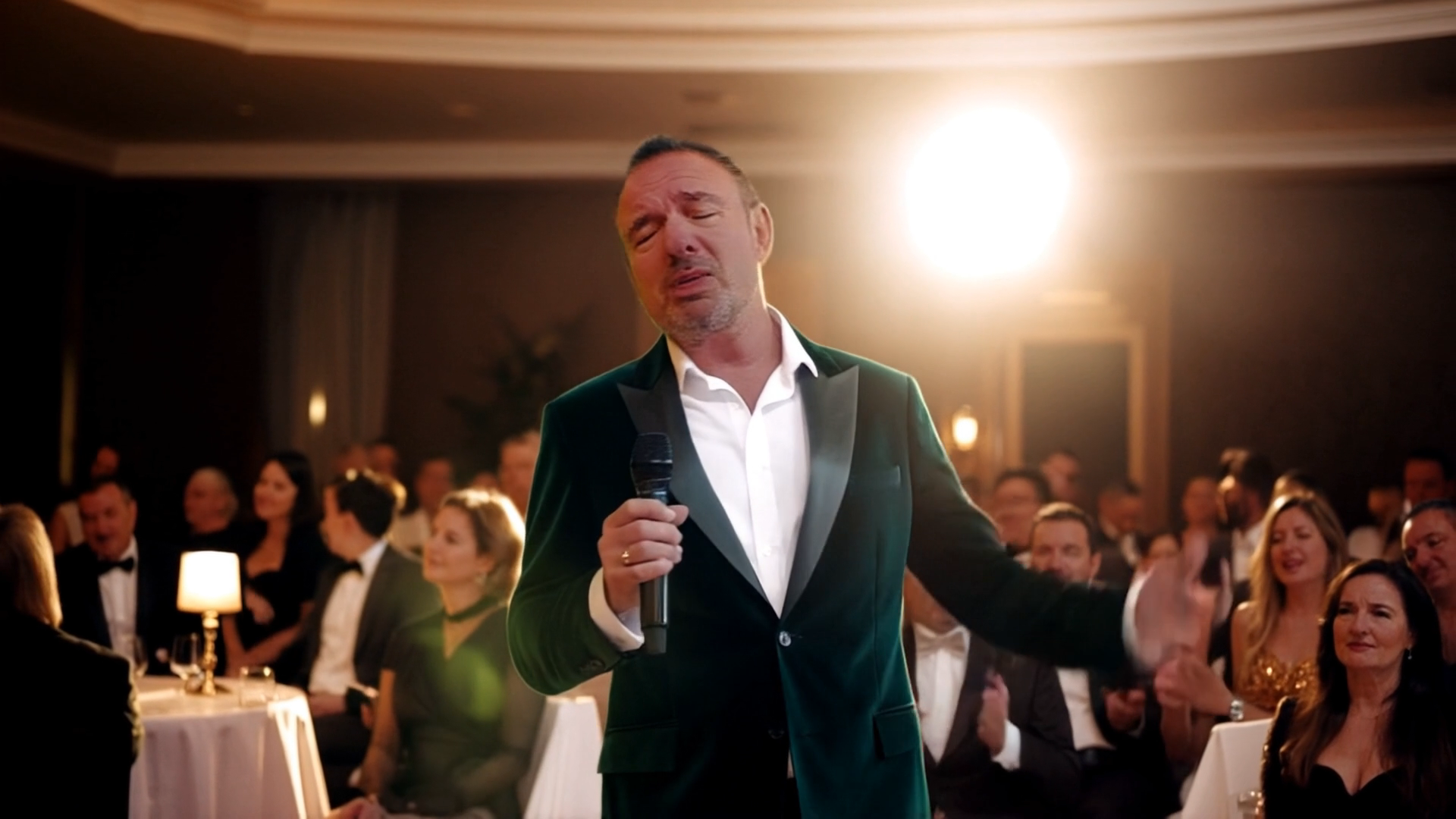Venue Booking Tips for Different Seasons
Journey through seasonal venue booking strategies to unlock hidden savings and create unforgettable events in any weather.
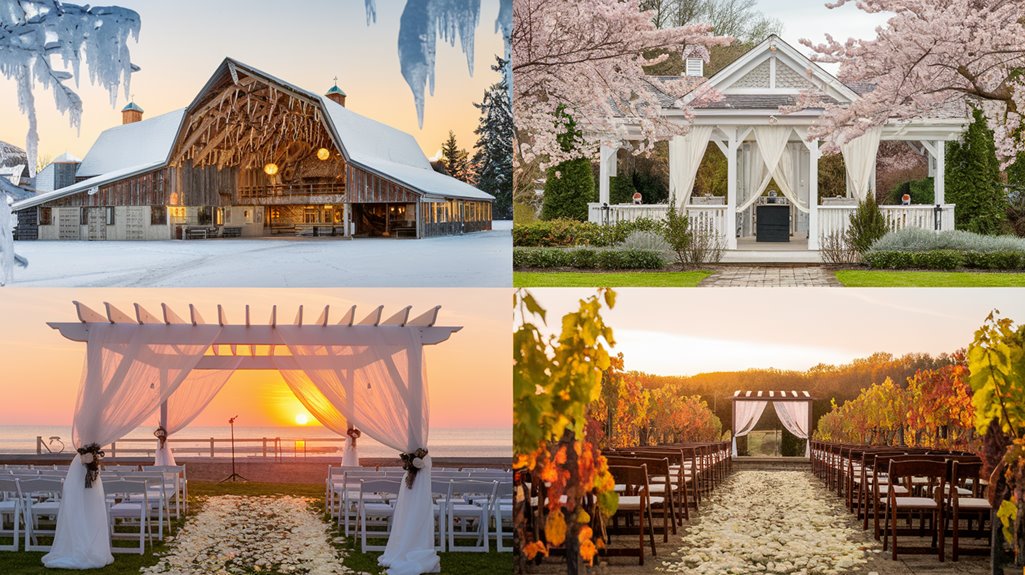
Consider booking your venue during off-peak seasons (winter and early spring) to save up to 50% on rates while gaining more flexibility in scheduling. You’ll need to account for weather patterns, temperature control, and backup plans specific to each season. Your décor, catering, and entertainment choices should align with seasonal themes and available resources. Smart timing can enhance your event’s atmosphere while protecting your budget. Discover how each season offers unique opportunities to make your event truly memorable.
Article Highlights
- Book during off-peak seasons (winter, early spring) to secure substantial discounts of up to 50% on venue rates.
- Ensure venues have robust backup plans including indoor spaces and weather protection for any seasonal challenges.
- Select menus and décor that align with seasonal ingredients and themes to enhance authenticity and reduce costs.
- Consider seasonal lighting conditions when planning photography sessions, particularly during sunrise and sunset hours.
- Verify temperature control systems and guest comfort features appropriate for your chosen season, including heating and cooling options.
Understanding Peak Vs Off-Peak Seasons
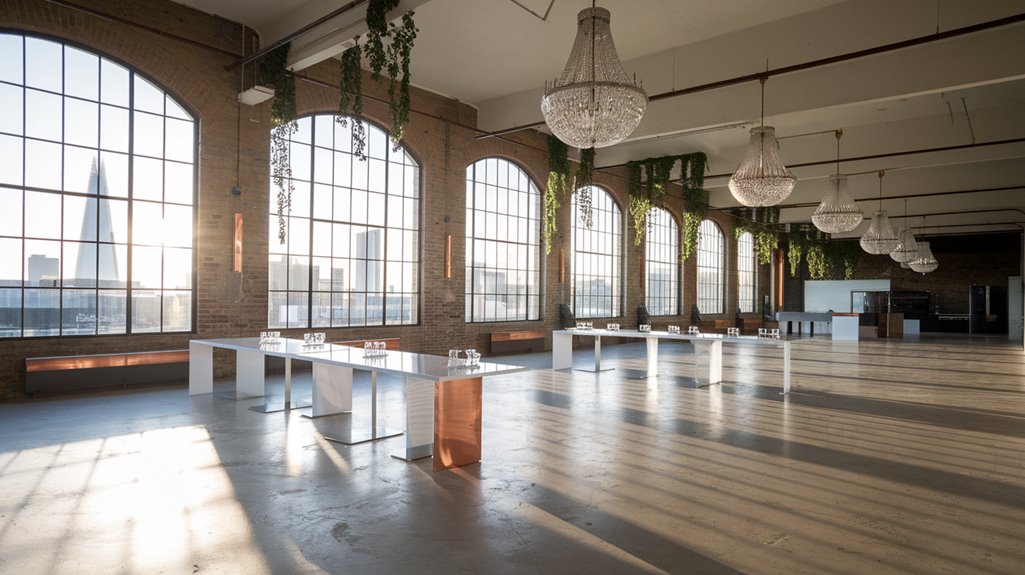
When planning your wedding, understanding the distinction between peak and off-peak seasons can greatly impact your venue options and budget. In the UK, peak seasons typically fall during late spring and summer, with June and September attracting the highest demand and correspondingly higher prices.
You’ll find substantial cost benefits by considering off-peak seasons like winter and early spring. Many venues offer attractive discounts during these periods to maintain steady bookings. Beyond savings, you’ll often discover greater flexibility in scheduling and more room for negotiation on package inclusions. While peak vs off-peak seasons present different advantages, remember to factor in local weather patterns and seasonal events. Off-peak seasons can also provide unique opportunities for themed decorations and seasonal elements that make your wedding distinctive while reducing competition for desired venues.
Weather Considerations for Each Season
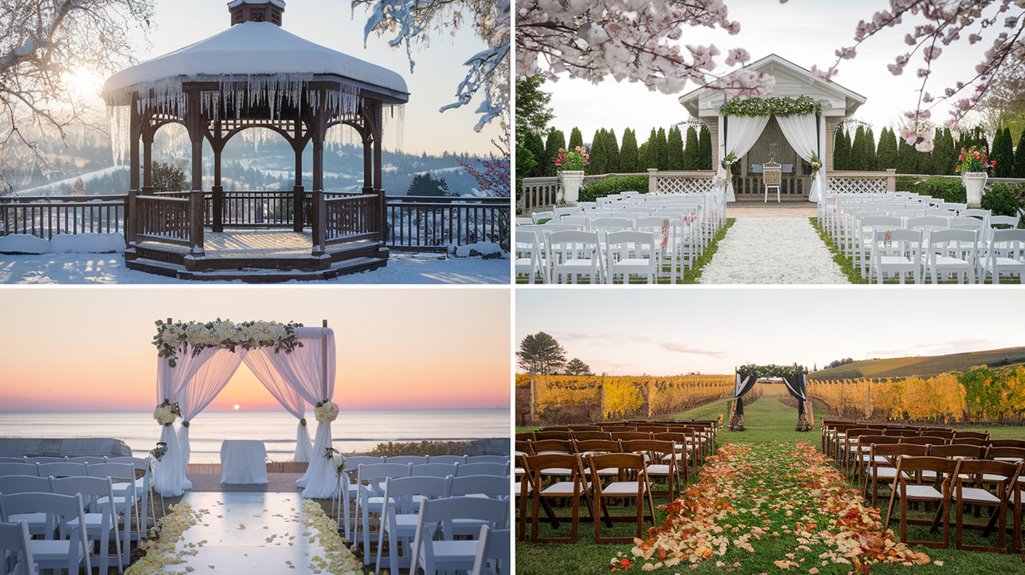
When choosing between indoor and outdoor venues, you’ll need to carefully assess each season’s weather patterns to determine the best setup for your event. Your indoor venue options should include proper temperature control systems and backup power, while outdoor venues require contingency plans like tents, fans, or heaters depending on the season. To manage temperature impacts effectively, you’ll want to contemplate guest comfort features such as shaded areas during summer months, weather-proof coverings for spring and fall, and adequate heating solutions for winter celebrations.
Indoor Vs Outdoor Planning
As you navigate the essential decision between indoor and outdoor venues, understanding seasonal weather patterns becomes paramount to your event’s success. You’ll need to carefully weigh the benefits and challenges of each option while developing robust contingency plans.
| Season | Indoor Considerations | Outdoor Considerations | Recommended Setup |
|---|---|---|---|
| Spring | Climate-controlled comfort | Risk of rain showers | Tent with clear sides |
| Summer | Air conditioning costs | Heat management needed | Shaded areas + fans |
| Fall | Earlier sunset timing | Stunning natural decor | Heat lamps + lighting |
| Winter | Cozy atmosphere | Weather challenges | Indoor primary + heated patio |
When planning indoor vs outdoor venues, you’ll want to assess not just the weather forecast but also guest comfort factors like temperature control, shelter options, and seasonal daylight hours. Don’t forget to secure appropriate permits and coordinate with vendors who have experience managing your chosen setting.
Temperature Impact Strategies
Maintaining ideal temperatures throughout your event requires strategic planning that varies considerably with each season. When selecting wedding venues, you’ll need to account for both indoor and outdoor temperature control strategies.
For spring events, guarantee your venue offers reliable indoor spaces to shield guests from frequent April showers. Summer celebrations call for venues with effective air conditioning or natural shade areas to combat temperatures reaching 22°C. During autumn, prioritize venues featuring indoor fire pits or heated outdoor spaces as temperatures drop to 9°C. Winter events demand robust heating systems to maintain comfort when outdoor temperatures hover around 3°C.
You’ll want to discuss specific temperature impact strategies with your venue manager, including backup plans for unexpected weather changes that could affect guest comfort in any season.
Seasonal Pricing and Budget Planning
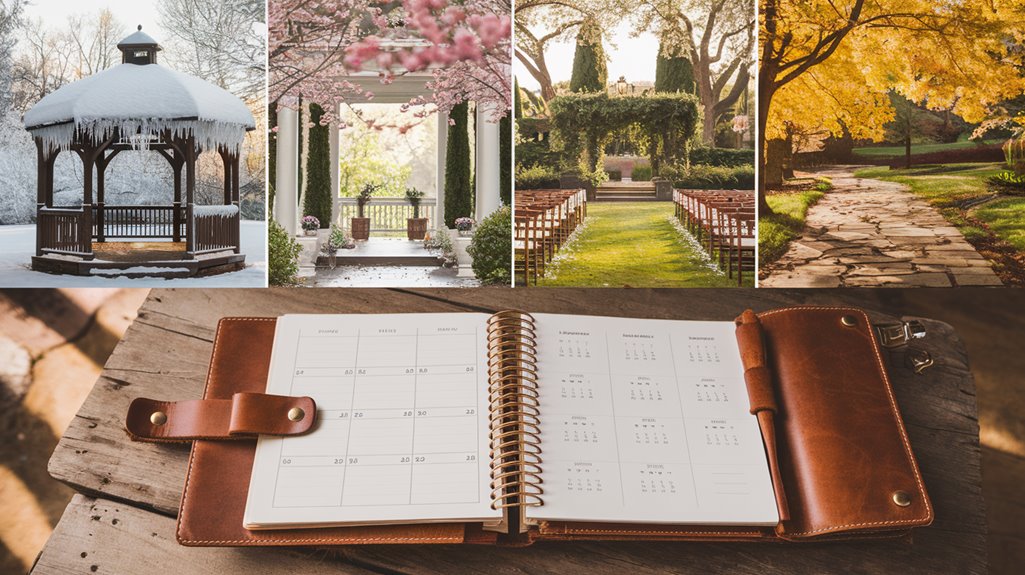
You’ll find significant price variations between peak and off-peak wedding seasons, with venues often charging 20-30% more during popular spring and summer months. By planning your wedding during off-peak periods like winter or early autumn, you can secure discounts of up to 50% on venue rates and take advantage of late availability deals ranging from 10-25% off. To maximize your budget, carefully evaluate each season’s complete package value, including factors like seasonal flower availability, local produce options, and guest travel costs, which can substantially impact your overall wedding expenses.
Peak vs. Off-Season Rates
When planning your venue booking, understanding the significant price variations between peak and off-season periods can dramatically impact your budget. During the prime wedding season, you’ll find rates typically 20-50% higher, especially for popular months like June and September. However, you can leverage these seasonal differences to your advantage.
Consider these strategic booking options:
- Book during January or February to secure up to 30% in venue discounts
- Choose weekday events over weekends for better rates in any season
- Reinvest peak-season savings into upgraded décor or extended service hours
Seasonal Package Value Guide
Every season brings unique opportunities to maximize your venue investment through strategically designed package options. When evaluating seasonal packages, you’ll find value variations of 20-30% between peak and off-peak months, allowing you to stretch your budget further.
Your seasonal package value guide should focus on both cost savings and enhanced features. Summer packages typically offer outdoor amenities and refreshment stations, while winter packages include indoor perks like fireplace access and holiday-themed décor. Consider the complete cost picture, including seasonal staff requirements and weather contingencies. You’ll want to factor in menu adjustments and décor elements specific to each season. By carefully weighing these elements against your budget, you can select a package that delivers ideal value while maintaining the atmosphere you’re seeking.
Adapting Décor to Match the Season
Transforming your venue’s décor to match the changing seasons can create a powerful and memorable atmosphere for any event. Each season offers unique opportunities to showcase nature’s palette and incorporate distinctive elements that resonate with your guests.
To maximize your seasonal décor impact:
- Spring and summer call for light, airy touches – incorporate fresh blooms, pastel hues, and natural elements like seashells or vibrant greenery
- Fall décor thrives on rich jewel tones and rustic elements, featuring textured fabrics, pumpkins, and warm lighting
- Winter venues shine with elegant metallic accents, evergreen branches, and soft, ambient lighting that creates an enchanting environment
Don’t forget to source local seasonal flowers and decorative elements – they’ll add authenticity to your venue while supporting area businesses and ensuring your décor perfectly reflects the season’s character.
Indoor Vs Outdoor Space Requirements
Deciding between an indoor or outdoor venue can dramatically impact your event’s success and guest experience. You’ll need to carefully evaluate your specific requirements and potential challenges for each option.
Indoor venues offer built-in amenities and climate control, making them ideal for winter events or smaller gatherings. You won’t have to worry about weather-related disruptions or additional infrastructure costs. However, outdoor venues provide natural beauty and flexibility for larger guest lists, though they require more extensive planning. You’ll need to take into account renting tents, restrooms, and creating accessible pathways for all guests.
When choosing your venue type, factor in your guest count, seasonal conditions, and budget constraints. Remember that outdoor spaces often incur higher costs due to additional equipment rentals, while indoor venues typically include essential amenities in their base price.
Seasonal Menu Planning and Catering Options
Selecting seasonal menu options can greatly enhance your venue’s appeal and create memorable guest experiences throughout the year. Your seasonal menu planning should reflect nature’s offerings while meeting your clients’ expectations for their events.
When developing your catering options, consider these key seasonal highlights:
- Spring and summer menus should feature fresh, light options – from spring asparagus and lamb to summer salads and invigorating fruit stations
- Fall menus can showcase hearty fare incorporating pumpkins, apples, and root vegetables that complement autumn events
- Winter offerings should focus on comfort foods like warm soups, roasted meats, and festive beverages that create a cozy atmosphere
You’ll find that aligning your menu with the seasons not only satisfies guests but also attracts more bookings, as clients seek distinctive culinary experiences that capture the essence of their chosen event date.
Lighting Solutions Throughout the Year
Proper lighting can make or break the atmosphere of your venue throughout the changing seasons. In spring, take advantage of natural daylight and soft warm lighting to showcase blooming flowers and create a romantic setting. Summer venues benefit from outdoor lighting solutions like string lights and lanterns, extending your event’s enjoyment into the evening hours.
When autumn arrives, use warm-toned lighting to enhance fall foliage colors, and consider uplighting to highlight architectural features. Winter events call for ambient lighting paired with candlelight to create an intimate, welcoming atmosphere during darker months. No matter the season, installing dimmers gives you the flexibility to adjust lighting levels for different activities, from energetic celebrations to quiet moments. This versatility guarantees your venue maintains the perfect ambiance year-round.
Backup Plans for Unpredictable Weather
When booking your venue, you’ll need to secure weather-ready indoor spaces that can accommodate your entire guest list in case Mother Nature doesn’t cooperate. Consider investing in outdoor shelter solutions like high-quality tents, canopies, or covered patios that provide protection while maintaining the ambiance of your chosen location. Establish flexible vendor arrangements early in the planning process, ensuring that all service providers can smoothly shift between indoor and outdoor setups without compromising the quality of your event.
Weather-Ready Indoor Spaces
The unpredictable nature of weather demands that your indoor venue space serves as more than just a backup plan – it must be a fully equipped, adaptable environment ready to host your event at a moment’s notice. Creating weather-ready indoor spaces requires thoughtful planning and strategic design elements that guarantee comfort and functionality regardless of external conditions.
To maximize your indoor venue’s weather readiness:
- Install robust heating and cooling systems that maintain ideal temperatures while incorporating natural light through weather-resistant windows and atriums
- Design flexible floor plans that can quickly transform to accommodate different group sizes and event styles
- Set up reliable backup power systems and establish clear contingency protocols in your booking contracts
These preparations won’t just protect against weather disruptions – they’ll enhance your venue’s overall appeal and versatility year-round.
Outdoor Shelter Solutions
Planning outdoor events requires robust shelter solutions that safeguard against nature’s unpredictability. You’ll want to take into account installing permanent structures like gazebos or canopies that provide reliable protection from both sun and rain. For more flexibility, rental tents with sidewalls offer quick-setup outdoor shelter solutions that adapt to sudden weather changes.
Don’t forget to incorporate heating elements such as patio heaters or fire pits to guarantee guest comfort during cool evenings. It’s essential to designate an accessible indoor backup space for seamless shifts if weather conditions become severe. When discussing outdoor shelter solutions with clients, be transparent about your weather contingency plans during the booking process. This proactive approach will help build confidence in your venue’s ability to handle any weather scenario.
Flexible Vendor Arrangements
Securing flexible vendor arrangements starts with building a reliable network of backup service providers who can adapt to sudden weather changes. When negotiating contracts, include weather-related contingency clauses that allow for quick modifications to your setup and service requirements.
To establish effective flexible vendor arrangements, you’ll want to:
- Research and partner with vendors experienced in both indoor and outdoor events
- Create a weather monitoring schedule with clear decision points for vendor adjustments
- Maintain ongoing communication with your venue about their preferred backup vendors
Work closely with your venue coordinator to understand their weather contingency protocols and align your vendor backup plans accordingly. You’ll want to guarantee your flexible vendor arrangements complement the venue’s existing partnerships while maintaining the quality and continuity of your event services.
Maximizing Natural Elements by Season
By understanding how each season uniquely transforms your venue’s natural surroundings, you’ll gain a significant advantage in creating enchanting event spaces throughout the year.
Make the most of spring’s natural blooms and greenery for vibrant outdoor ceremonies, while summer’s extended daylight hours let you maximize garden spaces and open-air terraces. You can transform your perfect venue in autumn by incorporating the season’s rich colors and textures into your décor scheme, embracing the warm, romantic atmosphere that fall naturally provides. During winter, shift your focus indoors and enhance spaces with strategic lighting, using candles and fairy lights to create an intimate ambiance. Don’t forget to integrate seasonal elements into your catering and decorations, as these thoughtful touches will elevate your venue’s appeal regardless of the season.
Transportation and Accessibility Concerns
While creating the perfect seasonal atmosphere sets the stage for your event, the success of any venue largely depends on how easily your guests can reach it. When evaluating transportation and accessibility options, you’ll want to guarantee your chosen location accommodates all attendees’ needs.
Consider these essential transportation factors:
- Check the venue’s proximity to public transit hubs, including bus stops and train stations, confirming regular service on your event date.
- Verify parking capacity, especially accessible spaces for guests with disabilities.
- Research seasonal weather patterns that could impact travel times.
You can enhance accessibility by providing detailed directions on your venue’s website and partnering with ride-sharing services or shuttle companies. Remember to factor in potential weather-related delays when planning, particularly during winter months.
Seasonal Guest Comfort Essentials
When booking your venue, prioritize spaces with reliable temperature control systems that can maintain guest comfort throughout the year, from efficient heating in winter to proper air conditioning in summer. You’ll need to confirm that seasonal amenities align with your event’s timing, such as cozy blankets and hot beverage stations for winter gatherings or shaded outdoor areas and cooling stations for summer functions. Don’t overlook seasonal decor elements and refreshment options that match the time of year, as these details greatly impact your guests’ overall experience and satisfaction.
Temperature Control Year-Round
Maintaining ideal temperature control throughout the year stands as a crucial factor in successful venue management. You’ll need to adapt your strategies based on seasonal changes to guarantee guest comfort remains consistent. For summer events, verify your venue has robust air conditioning systems and outdoor shade solutions, while winter gatherings require efficient heating systems and draft prevention.
To achieve effective temperature control year-round, focus on these key elements:
- Install adjustable climate control systems that can handle both heating and cooling needs for spring and autumn’s variable weather
- Use insulated materials throughout your venue to maintain stable indoor temperatures
- Implement portable solutions like fans, heaters, and shade structures to complement your primary temperature control systems
These measures will help you create a consistently comfortable environment for your guests regardless of the season.
Seasonal Amenity Must-Haves
Beyond temperature control systems, thoughtful seasonal amenities make the difference between an average venue experience and an exceptional one. Your seasonal amenity must-haves should align with weather-specific guest needs. In winter, offer heated blankets and warming beverages like mulled wine. Spring calls for covered outdoor seating and allergy-conscious choices to combat pollen season. During summer, you’ll want to implement cooling stations with fans and hydrating drink options like fruit-infused water. Fall venues benefit from fire pits and seasonal treats such as caramel apples. Remember to take into account both indoor and outdoor comfort – proper ventilation indoors complements your seasonal amenities outside. By anticipating these needs, you’ll create a more comfortable and memorable experience for your guests throughout the year.
Capturing the Best Photography Moments
To create timeless wedding photographs that truly capture the magic of your special day, understanding the interplay of lighting, seasons, and location is essential. You’ll want to work with a professional photographer who can maximize the golden hour’s warm, soft lighting during sunrise and sunset. They’ll help you leverage seasonal backdrops that complement your wedding theme naturally.
- Scout your venue beforehand to identify prime photo locations and ideal lighting conditions throughout the day
- Plan your photography timeline around the golden hour to capture stunning portraits with that coveted warm glow
- Embrace unique weather conditions that can add dramatic effects to your photos, from gentle snowfall to striking cloud formations
Your photographer should guide you in utilizing these elements while adapting to changing conditions, ensuring you’ll have breathtaking images that showcase your venue’s best features.
Seasonal Entertainment Options
When planning your venue’s entertainment calendar, understanding the unique opportunities each season presents can greatly boost your event’s success and guest satisfaction. You’ll want to tailor your seasonal entertainment options to maximize each period’s natural advantages.
Spring calls for outdoor activities like garden parties and lawn games, while summer’s extended daylight hours make outdoor movie screenings and BBQ events ideal. Take advantage of autumn’s harvest season with wine tastings and fall festivals that showcase seasonal produce and colors. During winter, shift your focus indoors with holiday markets and cozy winter wonderland experiences that feature warming beverages and festive décor. Don’t forget to maintain year-round appeal by incorporating adaptable entertainment options like live music or trivia nights that you can customize to match each season’s atmosphere.
Time Management Across Different Seasons
Managing your venue’s time effectively across seasons requires a strategic approach that adapts to predictable fluctuations in demand. Your time management strategy should account for the 30-50% increase in inquiries during peak wedding seasons, particularly late spring and summer.
To optimize your venue’s operational efficiency throughout the year:
- Utilize winter and early spring months for thorough maintenance and staff training programs
- Implement a detailed booking calendar that clearly distinguishes between peak and off-peak periods
- Schedule promotional events during slower months while encouraging early bookings for peak seasons
You’ll need to maintain a 6-12 month advance booking window during high-demand periods to guarantee proper resource allocation and prevent overbooking. This proactive approach allows you to maximize your venue’s potential while delivering consistent service quality year-round.
Vendor Availability and Seasonal Coordination
Since vendor availability fluctuates dramatically throughout the year, you’ll need to develop strong seasonal coordination strategies for your venue’s preferred service providers. Start by securing vendors 12-18 months in advance, especially during peak months like June and September when competition is fierce.
Consider timing your venue bookings during off-peak seasons to take advantage of potential vendor discounts and increased availability. Work closely with your florists and caterers to guarantee they can source seasonal ingredients and materials that complement your event’s vision. You’ll want to establish clear communication channels with all vendors regarding seasonal challenges, particularly for outdoor events. Discuss and document contingency plans for weather-related issues, and ensure everyone understands their roles in executing these backup strategies when necessary.
Frequently Asked Questions
How Early Should I Start Planning for a Specific Seasonal Venue?
You’ll need to start booking 12-18 months ahead for peak-season venues, while off-season venues require 6-8 months. Popular dates like holidays need even earlier planning, ideally 24 months ahead.
Are There Any Seasonal Restrictions on Noise Levels at Outdoor Venues?
Summer brings freedom, winter demands control – you’ll find outdoor noise restrictions vary seasonally. Check local ordinances, as many venues enforce stricter limits during quiet months and holidays.
Which Local Permits Are Required for Different Seasonal Events?
You’ll need event permits, noise permits, food service licenses, alcohol permits if serving, and special seasonal permits like winter street closure or summer entertainment authorizations from your local municipality.
Do Venues Offer Storage Facilities for Seasonal Decorations Between Events?
You’ll find that many venues offer storage options, but they’re often limited and may cost extra. Check your contract details and consider off-site storage facilities for larger decoration collections.
Can Venues Accommodate Last-Minute Changes Due to Unexpected Seasonal Allergies?
While sneezing guests scatter petals across your venue, you’ll find most event spaces can adjust seating arrangements, ventilation settings, and outdoor-indoor configurations to accommodate unexpected allergy concerns with proper notice.
Conclusion
As you plan your perfect venue, remember that each season paints its own masterpiece. Whether you’re dancing under autumn’s golden canopy or celebrating amid winter’s crystalline wonderland, your venue choice will set the stage for unforgettable moments. By carefully considering seasonal elements, from weather patterns to vendor availability, you’ll craft an event that flows seamlessly with nature’s rhythm while maximizing both beauty and budget.
